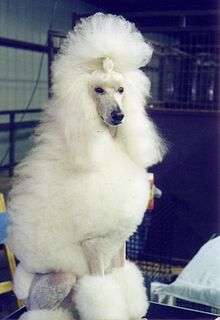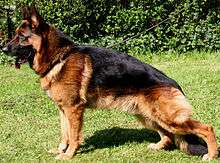The Intelligence of Dogs

The Intelligence of Dogs is a book on dog intelligence by Stanley Coren, a professor of canine psychology at the University of British Columbia in Vancouver.[1] Published in 1994, the book explains Coren's theories about the differences in intelligence between different breeds of dogs.[2][3][4] Coren published a second edition in 2006.[5]
Coren defines three aspects of dog intelligence in the book: instinctive intelligence, adaptive intelligence, and working and obedience intelligence.[6] Instinctive intelligence refers to a dog's ability to perform the tasks it was bred for, such as herding, pointing, fetching, guarding, or supplying companionship.[6] Adaptive intelligence refers to a dog's ability to solve problems on its own.[6] Working and obedience intelligence refers to a dog's ability to learn from humans.[6]
Methods

The book's ranking focuses on working and obedience intelligence. Coren sent evaluation requests to American Kennel Club and Canadian Kennel Club obedience trial judges, asking them to rank breeds by performance, and received 199 responses, representing about 50 percent of obedience judges then working in North America.[6] Assessments were limited to breeds receiving at least 100 judge responses.[6] This methodology aimed to eliminate the excessive weight that might result from a simple tabulation of obedience degrees by breed. Its use of expert opinion followed precedent.[7][8]
Coren found substantial agreement in the judges' rankings of working and obedience intelligence, with Border collies consistently named in the top ten and Afghan Hounds consistently named in the lowest.[6] The highest ranked dogs in this category were Border collies, Poodles, German Shepherds, Golden Retrievers, and Doberman Pinschers.[9]
Dogs that are not breeds recognized by the American Kennel Club or Canadian Kennel Club (such as the Jack Russell Terrier) were not included in Coren's rankings.
Evaluation
When Coren's list of breed intelligence first came out there was much media attention and commentary both pro[10] and con.[11] However over the years the ranking of breeds and the methodology used have come to be accepted as a valid description of the differences among dog breeds in terms of the trainability aspect of dog intelligence.[12][13][14] In addition, measurements of canine intelligence using other methods have confirmed the general pattern of these rankings[15] including a new study using owner ratings to rank dog trainability and intelligence.[16] 79 ranks are given (plus 52 ties), a total of 131 breeds ranked:[17]
Brightest Dogs
- Pembroke Welsh Corgi
- Miniature Schnauzer
- English Springer Spaniel
- Belgian Shepherd Dog (Tervuren)
- Schipperke
Belgian Sheepdog - Collie
Keeshond - German Shorthaired Pointer
- Flat-Coated Retriever
Standard Schnauzer - Brittany
- Cocker Spaniel
- Weimaraner
- Belgian Malinois
Bernese Mountain Dog - Pomeranian
- Irish Water Spaniel
- Vizsla
- Cardigan Welsh Corgi
- Chesapeake Bay Retriever
Puli
Yorkshire Terrier - Giant Schnauzer
Portuguese Water Dog - Airedale Terrier
Bouvier des Flandres - Border Terrier
Briard - Welsh Springer Spaniel
- Manchester Terrier
- Samoyed
- Field Spaniel
Newfoundland
Australian Terrier
American Staffordshire Terrier
Gordon Setter
Bearded Collie - Cairn Terrier
Kerry Blue Terrier
Irish Setter - Norwegian Elkhound
- Affenpinscher
Australian Silky Terrier
Miniature Pinscher
English Setter
Pharaoh Hound
Clumber Spaniel - Norwich Terrier
- Dalmatian
- Soft-coated Wheaten Terrier
Bedlington Terrier
Fox Terrier (Smooth) - Curly Coated Retriever
Irish Wolfhound - Kuvasz
Australian Shepherd - Saluki
Finnish Spitz
Pointer - Cavalier King Charles Spaniel
German Wirehaired Pointer
Black and Tan Coonhound
American Water Spaniel - Siberian Husky
Bichon Frise
King Charles Spaniel - Tibetan Spaniel
English Foxhound
Otterhound
Jack Russell terrier
American Foxhound
Greyhound
Wirehaired Pointing Griffon - West Highland White Terrier
Havanese
Scottish Deerhound - Boxer
Great Dane - Dachshund
Shiba Inu
Staffordshire Bull Terrier - Alaskan Malamute
- Whippet
Chinese Shar Pei
Wire Fox Terrier - Rhodesian Ridgeback
- Ibizan Hound
Welsh Terrier
Irish Terrier - Boston Terrier
Akita
- Skye Terrier
- Norfolk Terrier
Sealyham Terrier - Pug
- French Bulldog
- Griffon Bruxellois
Maltese - Italian Greyhound
- Chinese Crested
- Dandie Dinmont Terrier
Petit Basset Griffon Vendéen
Tibetan Terrier
Japanese Chin
Lakeland Terrier - Old English Sheepdog
- Great Pyrenees
- Scottish Terrier
Saint Bernard - Bull Terrier
- Chihuahua
- Lhasa Apso
- Bullmastiff
- Shih Tzu
- Basset Hound
- Mastiff
Beagle - Pekingese
- Bloodhound
- Borzoi
- Chow Chow
- Bulldog
- Basenji
- Afghan Hound
See also
References
- ↑ Coren, Stanley (1995). The Intelligence of Dogs: A Guide To The Thoughts, Emotions, And Inner Lives Of Our Canine Companions. New York: Bantam Books. ISBN 0-553-37452-4.
- ↑ Boxer, Sarah (1994-06-05). "My Dog's Smarter Than Your Dog". NewYork Times.
- ↑ Wade, Nicholas (1994-07-03). "METHOD AND MADNESS; What Dogs Think". NewYork Times.
- ↑ Croke, Vicki (1994-04-21). "Growling at the dog list". Tribune New Service (published in the Boston Globe).
- ↑ "Showing all editions for 'The intelligence of dogs : a guide to the thoughts, emotions, and inner lives or our canine companions'". WorldCat. Retrieved 2011-10-23.
- 1 2 3 4 5 6 7 Stanley Coren (July 15, 2009). "Canine Intelligence—Breed Does Matter". Psychology Today. Retrieved 2011-08-16.
- ↑ Hart, BL; Hart (1985). "LA". JAVMA. 186: 1181–1185.
- ↑ Hart, BL; Hart, LA (1988). The Perfect Puppy. New York: Freeman.
- ↑ Stanley Coren. "Excerpted from "The Intelligence of Dogs"". Retrieved 2011-10-23.
- ↑ Example: Perrin, Noel (April 10, 1994). "How Do Dogs Think?". Chicago Sun-Times.
- ↑ Example: "Coren's Canine List Has Owners Growling". April 30, 1994. Apr 30, 1994.
- ↑ Example:Csányi, Vilmos (2000). If dogs could talk: Exploring the canine mind. New York: North Point Press.
- ↑ Example:Miklósi, Ádám (2009). Dog Behaviour, Evolution, and Cognition. Oxford: Oxford University Press.
- ↑ Davis, SL; Cheeke PR (August 1998). "Do domestic animals have minds and the ability to think? A provisional sample of opinions on the question.". Journal of Animal Science. 76 (8): 2072–2079.
- ↑ Example: Helton, WS (November 2009). "Cephalic index and perceived dog trainability". Behavioural Processes. 83 (3): 355–358. doi:10.1016/j.beproc.2009.08.004.
- ↑ Coren, Stanley (2006). Why does my dog act that way? A complete guide to your dog's personality. New York: Free Press.
- ↑ "Ranking of Dogs for Obedience/Working Intelligence by Breed". Archived from the original on January 2, 2012.
- 1 2 3 4 5 6 Coren1995